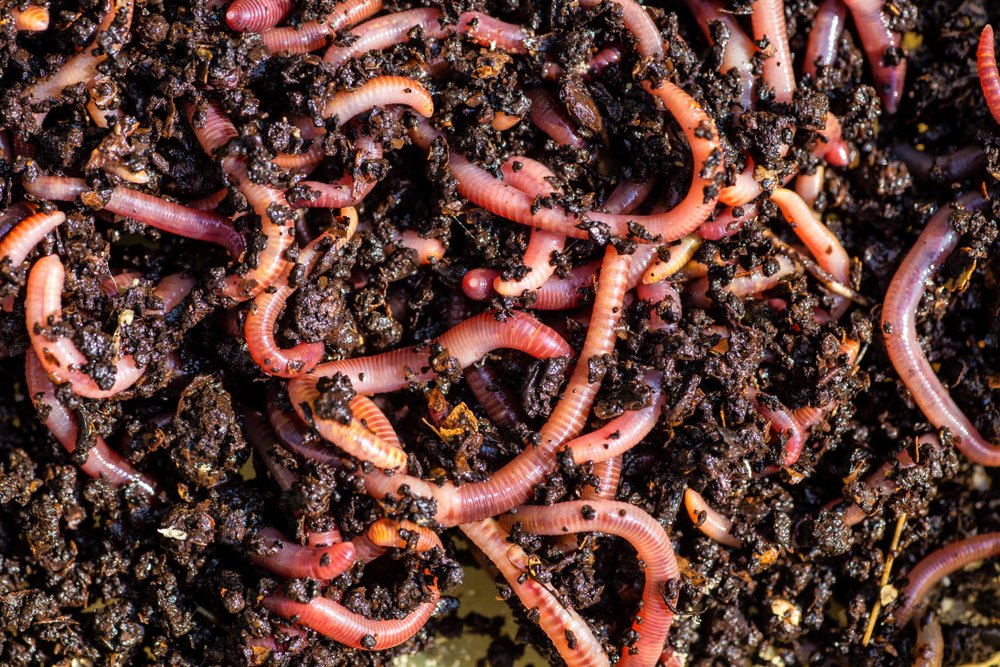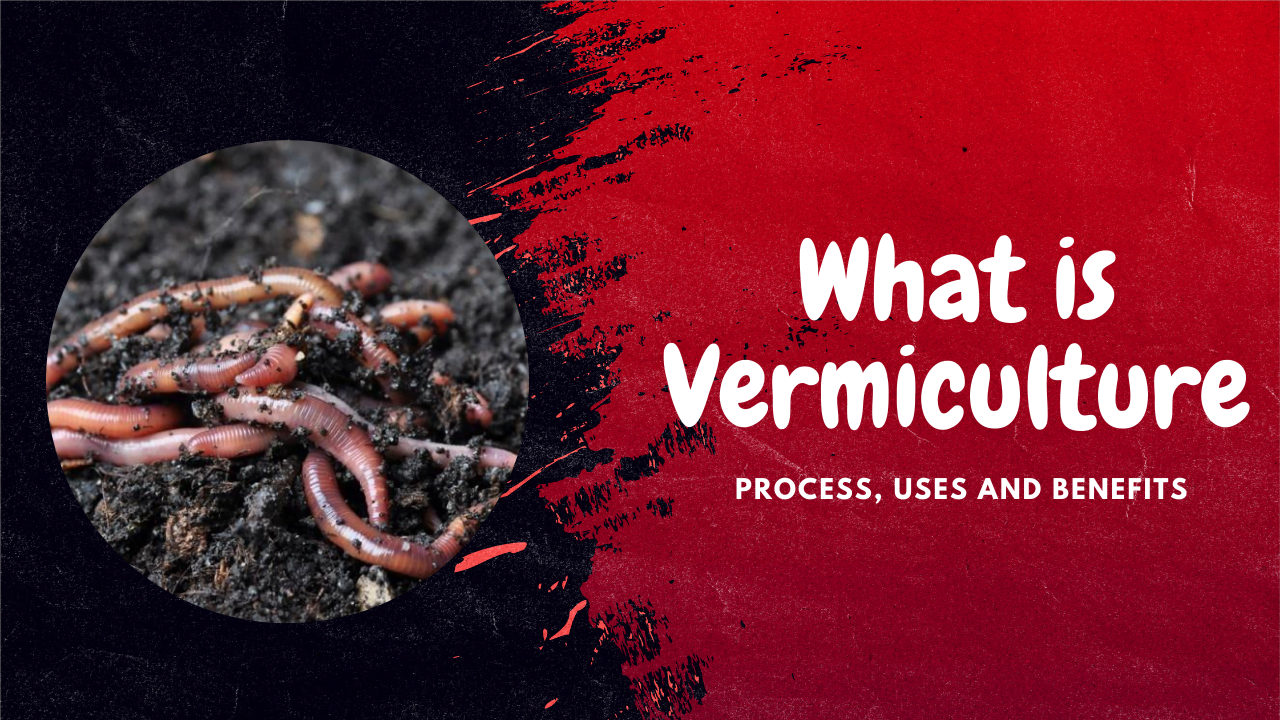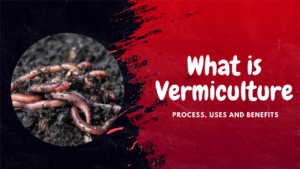You may have heard that earthworms are a farmer’s best friend. But why? Composting is the conversion of organic waste from plants and animals into plant manure. Vermiculture is one of the most efficient ways to speed up decomposition.
In this article, we will guide you on the vermiculture process, uses and benefits.
What is vermiculture?
The scientific practice of cultivating worms or artificially producing worms to break down organic food waste into nutrient-rich material is vermiculture. Vermicompost is the result of the process in which earthworms devour farmyard manure and roughages, farm trash, and so produce it. The resulting vermicompost is high in nutrients and other plant growth-promoting compounds and can provide essential mineral nutrients to aid and support plant growth.
But how did the vermiculture process come into existence? Let us brief you a little on the history of vermiculture.

History of Vermiculture
Mary Appelhif, a biology teacher, was the first to introduce the vermiculture process in the 1970s. She came up with the concept of converting kitchen garbage to worm compost using red wiggler worms (Eisenia fetida) in both indoor and outdoor systems. Her idea worked, and that’s how we got it.
Most people have the question in mind: Are there any vermiculture types? Yes, there are! Let’s get into the detail.
Types of vermiculture
1) Manual Process
The majority of commercial crop growers do not use manual methods. Instead, this vermiculture process is utilized by people who do it as a hobby and farmers who sell worms on a small scale. The manual method of worm harvesting is plucking the worms out of the soil with one’s hands.
Worms cannot tolerate direct light, and the hand-harvesting method uses this specific characteristic. This process involves keeping the worm-containing organic material on a flat, light-exposed surface. The worms will begin diving below the surface when this process completes.
Now, people will next remove the organic compost layer above it and stop when they can see the worms again. They repeat the process until there is no compost left except for the worms, which have a small amount of compost on their bodies. They immediately collect this in a container, calculate their weight, and deliver it once done.
This vermiculture process will likewise see many advancements and alterations. For example, instead of using a flat surface, people can use a container to place the organic material with the worms. When the area is small and the number of worms is high, this method of harvesting works.
2) Migration method
This vermiculture process is based on the worms’ tendency to migrate to new sites for food or because of light or dryness, both of which are harmful to the worms. Therefore, people prefer to use onion bags and screens for harvesting migration procedures.
Screens are used in one of two ways. The first is the simplest and most popular. In this vermiculture process, people use the bottom surface of the screen to build a box. It requires a mesh measuring between 1/5″ and 1/9″. Therefore, there are two options for this vermiculture process.
a) Downward-migration method
The manual harvesting approach is very similar to the downward-migration method. In this vermiculture process, a light is used to urge the worms to crawl. The difference between the screening system and the manual approach is that the worms will migrate downward through the screen into a container that has previously been weighed and is filled with moist peat moss.
The organic compost created in the box will be removed after all the worms have been transferred into the container through the screen. Then, people usually fill the box with the new worm-infested compost.
This vermiculture process will continue until the damp peat moss box is filled and has reached the desired weight. This method of collecting worms can also be set up in numerous locations simultaneously, with the harvester moving from one box to the next, saving time that would otherwise be spent waiting for the worms to migrate.
b) Upward-migration method
The upward-migration vermiculture process is similar to the downward-migration method, allowing worms to move upward. However, the mesh-bottomed box will be placed right in the worm bed in this case. First, people fill the box with peat moss before the worm-attracting food is spread on top. Coffee grounds and fresh animal manure are among the ingredients in this diet. After that, the box will be removed, and the weight will be measured. It is done after visually confirming that most of the worms had migrated into the organic material.
3) Mechanical Method
In this vermiculture process, a mechanical harvester is employed to catch worms. Separating materials is done with a trommel screen, also known as a rotary screen. It is cylindrical and measures around 11 feet long by 4 feet wide. Screened materials with varied mesh sizes make up the cylinder’s walls.
An electric motor powers the cylinder. The device is mounted on the trommel’s upper side at an angle. The mechanical harvester adds castings and worm beds after that. The worm castings will fall through the screen as the rotation begins, and the worms will migrate through the trammel mechanism and into the wheelbarrow.
Types of Earthworms used in Vermiculture
Earthworms are crucial in decomposing organic waste in the soil, making it fertile for agricultural use. In other words, earthworms recycle organic waste produced by various life forms to create humus, enhancing the soil quality required for cultivation. Earthworms are divided into four categories (ecotypes) depending on their feeding and burrowing patterns in the vermiculture process.

1) Epigeic earthworms
These kinds of earthworms reside in the top layer of the soil. These aren’t digging earthworms; instead, they feed on soil litter to stay alive. These earthworms are quite small. They are crimson to red-brown and are not stripped.
2) Endogeic earthworms
These are burrowing. These worms dig horizontal burrows and eat organic stuff beneath the soil surface. Endogeic are little and feed on rich soil. These earthworms are not colored and appear to be pallid.
3) Anecic
These earthworms feed on soil litter by burrowing into the soil in permanent vertical deep holes. As a result, these earthworms can be found in both shallow and deep soil burrows. Worms’ castings can commonly be found in meadows. These earthworms are enormous and have dorsally colored bodies. The head portion is red or brown, and the tail is light compared to the head portion.
4) Compost
They are usually found in a compost pit. Moisture, warm climatic conditions, and easily available compost material are ideal for these earthworms. Vermicompost is created when earthworms consume compost material. The earthworms in this picture are striped and red.
When we are clear on what kinds of worms are there, the next question is, what are the things required for this process?
Process of Vermiculture
Organic Materials:
Earthworms eat organic materials as a source of nutrition. As a result, it is a prerequisite for the vermiculture process to begin. Examples of organic materials include food waste, animal waste, agricultural trash (agro-waste), and plant waste. The following qualities must be present in the raw vermiculture mixture:
- It should have a moisture content of 75%.
- It should be free from any pesticides, chemicals, and tannin residues should be absent.
Earthworms:
The most common earthworm used for vermiculture is Eisenia fetida, often known as the red wiggler. Because of their high metabolic rate, they are a favorite pick. Within 45 to 50 days, they can transform the organic matter into vermicompost.
Preparation

1) You should take a container with adequate dimensions and a worm bed to put it in its pit. To create a worm bed, you can use old paper, sugar cane rubbish, paddy husk, and coir waste. Cover this mixture with a thin layer of soil, and try to maintain the humidity at 40-45 percent.
2) A mixture of organic waste, biogas plant slurry, and cattle manure is put over the bed and left for partial digestion for two weeks. The temperature of the worm bed will rise to 50-55 degrees Celsius during this period. Then, a 5-10% neem cake is applied to eradicate dangerous germs.
3) When the temperature lowers to 30 degrees, it’s time to bring the earthworms. For every 100 kg of organic material, 500 earthworms are used.
4) The bed is covered in straw and jute clothing to keep the worm safe. People often keep the temperature between 20 and 30 degrees Celsius and manage the moisture content between 45 and 50 percent. (pH range: 6.5-7)
5) In around 60 days, the compost will be ready, and the worms will be separated by spreading the Vermicompost on a plastic sheet in a heap in the sun. Because earthworms are light-sensitive, they will gravitate to the bottom of the heap, allowing the top layer of compost to be removed.
We have covered the vermiculture process in detail; it’s time to dive into the advantages and disadvantages of vermiculture.
Advantages of Vermiculture
- It is considered to be a pocket-friendly method.
- The benefits of vermiculture include assisting in plowing, fertilizing the soil, and supplying the necessary nutrients to the plants.
- The earthworms will aid in the improvement of soil structure, fertility, and the stimulation of soil aggregation.
- It encourages plant growth, resulting in increased agricultural productivity and quality.
- Earthworms can also boost the rate of water infiltration. The earthworm tunnels will aid in the absorption of water by the soil.
- The earthworms will increase the minerals in the soil, increasing the number of nutrients available to the plant.
- These earthworms can also be used as pet food and fish food.
- The advantages of vermiculture include balancing the pH of the soil. The farmer will be able to evaluate if the soil’s pH level is in a neutral state by analyzing the castings released by the earthworm.
- The earthworms will compost the plant wastes and clean the waste.
- Earthworms promote the growth of microorganism populations. The microorganisms that aid in nitrogen fixation can be found in abundance surrounding earthworm burrows.
- It helps reduce the amount of water and energy waste disposal systems use.
- It requires less labor, less space, and minimal maintenance.
Disadvantages of vermiculture
- It is a time-consuming process that takes approximately 6 months.
- You may find a slight odor during the process.
- Maintenance is significant because it must be kept in good functioning order for an extended period.
- There is a chance of infection and insect concerns if you aren’t paying enough attention.
Is any significant vermiculture uses? Indeed, there are! We are mentioning its possible uses of it.
Vermiculture Uses
1) To improve land quality
Due to the continuous use of pesticides or chemical fertilizers, urbanization has resulted in long-term soil degradation and poor land quality. In addition, it results in the loss of topsoil, rendering the area unusable for cultivation. Therefore, this technique is for improving land and soil quality.
a) Cultivation: Earthworm cultures (starting culture) are made by mixing soil and earthworms and feeding them together (organic wastes).
b) Soil inoculation: Starter cultures are placed in the soil, where they migrate in a radial pattern. Migration is influenced by various parameters, including soil quality, moisture content, and organic matter availability. The starter cultures are observed for ten months for the best outcomes, and the cultures that survive in the soil are chosen to improve land quality.
2) Fish feed substitute
Vermicast makes worm casting, which is used as a fish feed substitute. However, an excessive amount of vermicast may harm water pH. As a result, people take enough caution when using it as an alternative feed.
3) Human health care
These are also utilized in the production of some therapeutic items. Here are two examples:
a) Anticoagulants:
These medications help persons who have internal blood clots obstructing blood vessels. Blood clotting is known to be prevented by earthworm extracts produced from vermicast and cultured earthworms.
b) Antioxidants:
Examples include earthworm paste, earthworm extracts, and coelomic fluid. Some studies have shown that fluids derived from earthworms contain antioxidant properties. Earthworm extracts can give electrons to reactive species like free radicals, which stabilizes them, explaining their antioxidant effect. The antioxidant activity of earthworms is believed to be due to this mechanism of stabilizing reactive free radicals.
Frequently Asked Questions
Ques1: Why is vermiculture beneficial?
Ans: It is beneficial because it produces organic fertilizer, which improves soil quality in terms of nutrition, moisture content, water holding capacity, aeration, and other factors. Vermicompost made through vermiculture contains macro and micronutrients, as well as critical minerals that are essential for plant growth and development.
Ques2: What is the main difference between vermiculture and vermicomposting?
Ans: Vermiculture is the cultivation of earthworms to degrade organic wastes into nutrient-rich fertilizers, while vermicomposting is the cultivation of earthworms to use them to decompose organic wastes into nutrient-rich fertilizers.
Ques3: Is vermiculture a good idea?
Ans: Yes, it is. Worms are used to assist in composting, speeding up the process and increasing the efficiency with which the materials are broken down. As the worms munch their way through the substance, they aerate it by tunneling through it. It aids aerobic decomposition. Their feces, a wonderful soil amender, also adds to the mix. Worm castings or worm excrement improve the finished compost and make it more helpful to soil and plants.
Ques4: What advantages does vermicompost have over regular compost?
Ans: The following are some of the advantages of vermiculture:
Worm compost is far superior to conventional compost in terms of quality.
The compost particle size of vermicompost is less than 2 microns, which is smaller than regular compost.
Vermicompost increases soil water retention, drainage, aeration, and soil stability.
Compared to regular compost, vermicompost has more natural plant growth hormones and antimicrobial properties.
Ques5: What exactly is worm tea?
Ans: Worm tea is the worm liquid found at the bottom of the compost pile. It is extremely valuable to the development of plants.
Conclusion
Vermiculture is a great method of increasing plant and soil fertility. It is primarily concerned with worm breeding to increase its population. It is then prepared to aid crop growth and development. Earthworms not only turn garbage into valuable manure but also help maintain the ecosystem’s health. There are many vermiculture uses and benefits.
If you have any questions regarding the same, mention them below.
Related Articles
- Top 10 Organic Fertilizers: Boost Your Plant Growth Naturally
- NPK Fertilizer: Everything you need to know
- What Are The Advantages And Disadvantages Of Vermicomposting?
- Fertilizer for Indoor Plants: How and When to Fertilize Houseplants
- Bonsai Tree Fertilizer 101: Essential Nutrients and Techniques for a Thriving Tree
- What is Vermiculture: Process, Uses and Benefits








This web site definitely has all of the information and facts I needed concerning this subject and didn’t know who to ask.